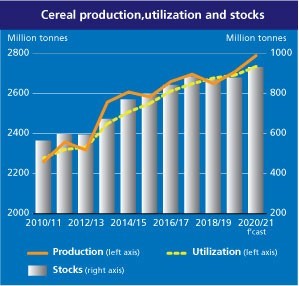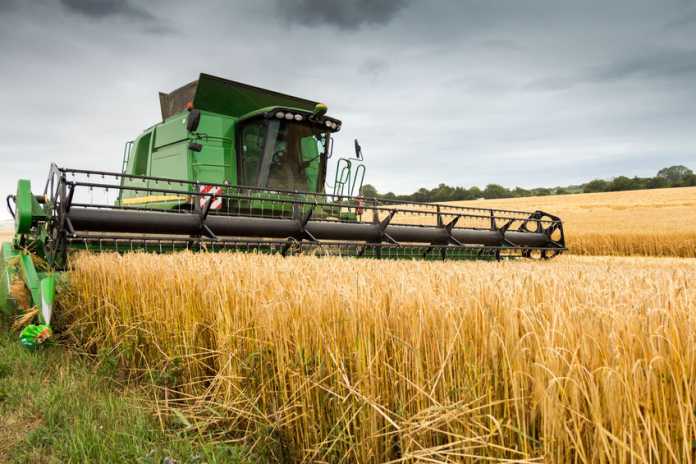Google News is promoting a story published by PropertyCasualty360.com, claiming global warming threatens “catastrophic crop loses,” from an increase in extreme weather events.
However, data from the United Nations Intergovernmental Panel on Climate Change (IPCC) and the National Oceanic and Atmospheric Administration (NOAA) show there has either been no increase or even a modest decline in the common types of extreme weather events that result in crop losses: drought, floods, and late-season frosts. Also, data from the U.N. Food and Agriculture Organization (FAO) show crop production is setting new records almost every year during the past few decades of modest warming.
The PropertyCasualty360.com article published today, titled “Climate change may greatly increase the risk of future crop loss,” is speculative enough that the journal can’t be accused of lying. After all, climate change could cause future crop losses, but, based on existing evidence it is more likely to result in crop increases. The available data clearly show the recent modest warming has produced crop and yield increases.
“Climate change and its impact on the weather has the potential to reduce corn crop yields by as much as 20%-40% by the mid-century point (2046-2055), according to four climate model simulations conducted across the Corn Belt, a study by AIR Worldwide and Verisk found,” says PropertyCaualty360.com. “‘There is justified concern about effects of recent and future climate changes on agriculture both in the United States and across the globe,’” said Dr. Peter Sousounis, vice president and director of climate change research for AIR Worldwide, according to PropertyCasualty260.com. “If, or when, climate change brings with it more frequent and/or more extreme unfavorable weather to areas of significant crop production, such as the Midwestern United States, the potential for significant crop losses and economic impacts could be heightened.”
Contrary to climate models projections, the data is clear that recent changes in the climate have produced more favorable conditions for crop growth, resulting in increased production and yields.
Historically, drought has been among the biggest threats to crop production. As Climate at a Glance: Drought reports “real-world data show drought in the United States has become less frequent and severe as the climate has modestly warmed.” Indeed, the United States is undergoing its longest period in recorded history with fewer than 40 percent of the country experiencing “very dry” conditions. The IPCC reports with “high confidence” that precipitation has increased over mid-latitude land areas of the Northern Hemisphere (including the United States) during the past 70 years, while IPCC has “low confidence” about any negative trends globally. Less frequent drought means more abundant crop production and more abundant water resources.
Data from the IPCC and NOAA also demonstrate flooding has not increased amidst the recent warming. The IPCC admits having “low confidence” in any climate change impact regarding the frequency or severity of floods. Going further, the IPCC reports “low confidence” in even the “sign” of any changes—meaning, it is just as likely that climate change is making floods less frequent and less severe as it is to be making them more frequent and severe.
The IPCC and NOAA report climate change is both reducing the number of cold days and nights and producing a decline in the number of crop-stunting late season frost events. The IPCC’s latest report also says it is “virtually certain” that there will be “deceases in cold extremes” due to global warming. Fewer extreme cold events and late season frosts mean longer growing seasons.
Data on crop yields and overall production verify the beneficial effects of a modest global warming.
FAO reports crop production is setting new records almost every year during the past few decades, as the figure below shows.

As reported in Climate Realism, here, here, here, here, here, here, here, and here, for example, for crop after crop, in country after country, records for annual yield and production are set almost yearly.
The reasons for booming crop production are well documented in the Non-Governmental International Panel on Climate Change volume, “Climate Change Reconsidered II: Biological Impacts. Global warming lengthens growing seasons, reduces frost events, and makes more land suitable for crop production. Also, carbon dioxide is an aerial fertilizer for plant life. In addition, crops use water more efficiently when benefiting from more atmospheric carbon dioxide, losing less water to transpiration.
Rather than heeding the Chicken-Little warnings of researchers who follow models rather than data, insurers who read PropertyCaualty360.com should take heart from the real world evidence. Data show climate change is most likely moderating weather extremes, which is contributing to record crop production. Rather than increasing, crop losses are declining in the United States and globally.

















